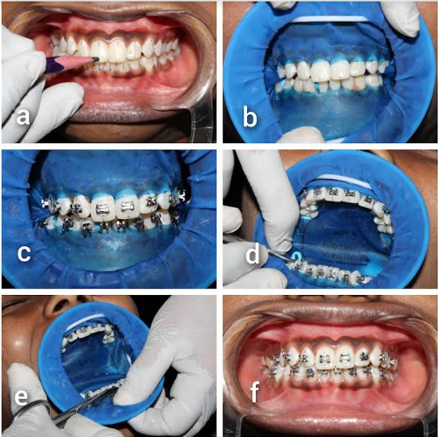Introduction
The need for perfect isolation during etching and bonding is mandatory in orthodontics. Though Sanford Christy Barnum advocated the use of rubber dam in 1991 it is seldom used in orthodontics1 due to the misconception that it is a cumbersome method to engage rubber dam to the teeth. Besides the difficulty of applying the rubber dam, bonding in both arches simultaneously and observing the long axis of the teeth while bonding was impossible while using conventional rubber dam. However, isolation using rubber dam could provide a contrasting field to view the teeth to be bonded, avoids tongue interference, provides an absolutely moisture-free working environment and increases patient comfort. 2 The main reason for this difficulty is, we are trying to fit a rectangular rubber dam sheet into an oral cavity which is oval in shape when opened.
Rubber dam protects the patient from ingestion and inhalation of potentially toxic mucosal and aerosol products containing pathogens. This aspect is even more important in the COVID-19 pandemic like situations as rubber dam reduces 70% production of droplets or aerosols contaminated by the patient’s saliva or blood within a range of one metre radius.3
The British Orthodontic Society has published the guidelines on the risk of aerosol generating procedures (AGPs) during orthodontic treatment. The various AGPs in orthodontics are, the use of three- way syringe during bonding procedure, proximal stripping, removal of composite attachments after aligner therapy, placement of lingual retainers and removal of composite remnants after debonding Thus using rubber dam in each of these procedures is an excellent idea to be implemented.4
This article details a step–wise method by which rubber dam could be easily engaged to all the teeth.
Stepwise method in bonding
The teeth to be bonded were cleaned and polished
Long axis of the teeth were marked using a pencil (Figure 1 a)
Cotton rolls were placed in the lingual sulcus to help control the salivation that would occur during the procedure. The patient was instructed to swallow the saliva that would form inadvertently.
Holes were made in the rubber dam corresponding to the template using the rubber dam punch. The rubber dam used in this method is the optradam which has a circular framework to facilitate easy placement of the dam.
It has two flexible rings. The inner ring of the rubber dam was folded and inserted into the oral cavity. Once the inner ring enters the oral cavity properly, the outer ring automatically retracts the lip neatly.
The rubber dam was pulled on to the teeth corresponding to the holes on the dam.
The dam was stretched inter dentally and the insertion was made perfect using a dental floss.
Instead of a rubber dam clamp, the rubber dam was secured in place using separators or wedges between the posterior most teeth (Figure 1 b).
The teeth were conditioned after applying etchant and primer
Brackets were loaded with adequate composite material and placed in the desired position. Care was taken to maintain the long axis of the teeth. The height of the bracket placement was predetermined using the MBT chart. All the teeth were bonded similarly (Figure 1 c).
To retrieve the rubber dam separators are carefully removed (Figure 1 d) and the labial portion of the dam was stretched and carefully cut with a pair of blunt ended scissors (Figure 1 e). This helps in easy retrieval of the rubber dam.
The inner flexible ring was removed from the mouth thus completing the bonding procedure (Figure 1 f).
Conclusion
A clean and moisture-free working environment is what most orthodontists prefer during bonding procedure. The practical difficulty of controlling the tongue is simplified by using the rubber dam. This method also avoids the use of conventional clamps and frames. Orientation of the bracket three-dimensionally is possible in this method. Implementing the use of rubber dam to improve our bonding procedure would definitely increase the standard of infection control in our orthodontic practice.

